
Newsletter
Eighty percent of all dogs have some form of dental disease and gum disease can be very severe. Dental disease affects much more than fresh breath. It frequently leads to more serious health problems such as liver, kidney and heart disease. One new development is the prevention of plaque using a barrier sealant gel. This is applied by the veterinarian and then continued at home. Watch this video to learn more.
So you've added a pet cat to your family. Maybe you imagined yourself sitting down with a big furry Persian in front of the fireplace, petting him and listening to him purr. Or maybe you liked the idea of having a perky little tabby greet you at the door after your work day was finished. Perhaps it was the thought of a playful kitten waking you up in the morning.
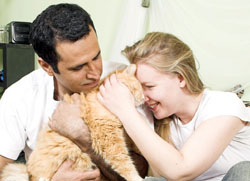
Cats can be wonderful companions. But sometimes things don't work out exactly the way you thought they would. Maybe your new cat would rather rest on the chair at the other end of the room than lie down on the sofa next to you. Or perhaps your cat has even hissed at or scratched you when you tried to pick him up.
Often, when people don't live happily with their cats, it's because the pet owners didn't establish a good bonding when they first brought the kitty home.
Bonding is the first step toward successfully living with your cat. Bonding means creating a personal relationship between you and your pet. This includes mutual respect, trust and love. You are a special person to your cat, and your cat should be special to you.
It's important that each member of the household develops his or her own unique relationship with the family cat. The person who bathes, feeds and trains the cat may bond as a substitute mother. A child who plays with the cat may relate to him as a brother or sister, and the person who sits quietly with the cat on his or her lap and pets him may bond as a friend.
It's easiest to bond with a new kitten, but even if your cat is an adult and you've had him for several months or even years, it's still possible to strengthen the bond you have with him if you are willing to work at it.
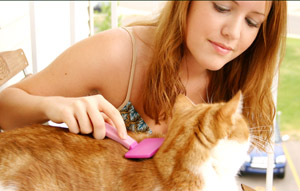
Here are 10 suggestions for building a solid bond with your feline friend:
- Include your cat in your daily activities. Invite your cat to be with you while you clean house, watch television, sort through the mail, work at the computer or read the newspaper. The more activities your cat observes you doing, the more he will trust you in all situations.
- Talk often to your cat. Verbal communication is one of the most important aspects of bonding. Don't feel silly sitting down and talking to your cat. He may not understand the words you use, but he can understand a warm, friendly tone of voice. Use your cat's name often. This will grab his attention and establish a personal relationship between the two of you.
- Get to know your cat's individual personality. Every cat is different; some are shy and independent, while others are outgoing and crave attention. Adapt your lifestyle to the particular personality of your cat. Try different behaviors on your cat and see what works. If you want your cat to be affectionate, you have to determine what you can do to make him act that way.
- Provide a consistent daily routine. Cats don't like surprises. They feel safe and secure with a routine. Establish an acceptable daily schedule with your cat early in the relationship. Let him know how often and when to expect meals, walks on the leash and play sessions. Don't spend two hours a day with your cat one week and only a few minutes a day with him the following week. You also should be consistent with the behaviors you allow and don't allow. Don't yell "no" when he jumps on the counter today and then let it slide tomorrow. If you are inconsistent in how you interact with your cat, you will confuse him and he won't feel as though he can trust you.
- Give a new cat plenty of privacy. When you bring a new cat into your home, you should give him a room of his own for two to four weeks. Sit in the room for an hour a day, reading or just relaxing, but don't force the cat to interact with you. Make yourself available, but let your cat be the one to make the first move. If your cat starts walking toward you, put some catnip or other treat around your chair. This encourages the cat to move toward you. Never reach out to grab a frightened cat nor drag a cat out from under a chair. It's important that you respect your cat's fears and inhibitions. Remind yourself that he is in a new environment. Go especially slow with an older, adopted cat who may have been a stray. Give your cat time to see you're not a threat, and eventually he will leave himself open to develop a relationship with you.
- Avoid harsh corrections. If your cat misbehaves, do not hit, holler or punish him. You can tell him "no," but do so only to stop unacceptable behavior. Don't yell or scream. You can use a squirt bottle or air horn to stop your cat from scratching your furniture or drapes, but be careful not to link yourself with the correction. Hide the squirt bottle as you spray. You want your cat to think the drapes have a life of their own, that the drapes did the squirting. If the cat thinks you did it, it may be harder to bond with him.
- Provide frequent play and exercise. Play with your cat several times each day using tossed toys, fishing pole toys, rolled balls or other interactive cat toys. By playing with your cat and giving him things to do, you build a bond because the cat is thinking, 'when mom or dad is home, I have more fun.' This causes the cat to welcome you that much more. If you're a positive object in your cat's life, he's going to seek you out. Avoid tug-of-war and other games that encourage aggressive behavior. Resist the temptation to roll your cat on his back and rub his tummy. When you do that, you encourage the cat to use his claws and teeth on your hands. It seems like that's a lot of fun, but cats get overexcited and can become quite aggressive as a result.
- Touch with affection. Show your cat you care about him - stroke his fur, pat his head, scratch behind his ears, even gently squeeze his paws. Physical contact is a wonderful way to make your cat feel loved. However, avoid quick, jerky movements that might startle him.
- Hold your cat securely. Pick up your cat firmly, but gently, supporting his entire body. If you let his limbs dangle, he will resist and may struggle or bite you. Hold your cat by sliding your right hand between his front legs and around his upper body. Put your left hand under his rear end and around the outside of his body, pulling him into you so he feels secure. You want your cat to trust you; you don't want him to feel as though you're going to drop him.
- Give your cat the time he needs. Some people buy a cat and want a best friend immediately. Bonding is not automatic. It may take a couple of weeks to bond with a kitten and several months to bond with an older cat. Having a strong bond with your cat takes time. Go slowly and don't expect too much too fast.
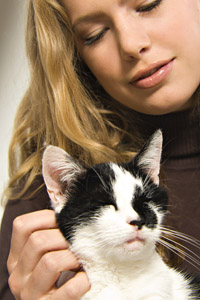
You will have both good and bad days with your cat. Like people, now and then cats get grumpy, be patient and understanding. Treat your cat as a good friend and sooner than later, he'll be one.
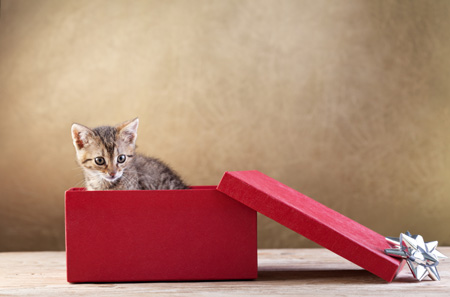
The American Society for the Prevention of Cruelty to Animals has advocated against giving pets as gifts for decades, but a new survey has caused them to change their tune. According to a telephone survey conducted by the ASPCA, 96 percent of pet owners who got their pet as a gift – whether it was a surprise or not – either increased or didn’t impact their attachment to the animal. Of those owners, 86 percent still remained in the home, which is the same rate as pets obtained in other ways.
While some shelter owners remain skeptical, others have ramped up holiday adoptions in response to the new information. While in the past, many shelters would close around Christmas, this year many plan to remain open and some will even deliver pets to homes on Christmas day.
A well-behaved dog is the product of teaching him to understand what is expected; you are responsible to teach him what behavior is or is not tolerated. As the owner of a new puppy, training is necessary and mutually beneficial. Young puppies are a veritable behavioral blank slate. If you are able to take advantage of this special time and begin temperament and basic obedience training using gentle, positive reinforcement methods, you are much more likely to end up with a well-behaved, sociable companion for life.
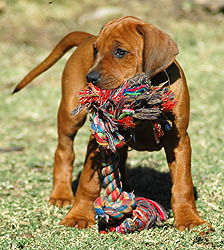
Benefits of early puppy training include:
- Instilling good manners
- Utilizing your puppy's critical socialization period to familiarize him with all kinds of people, animals, and environments
- Getting him used to being handled and touched
- Stimulating his abilities
- Troubleshooting common puppy problems like play-biting, chewing, digging and housebreaking before they become inconvenient dog problems
Obedience Training
The classes to look for should include information and instruction on how to communicate with your puppy. Housetraining, chewing, bite inhibition, off-leash socialization, handling, house manners and often an introduction to basic obedience skills should be part of your puppy's program. Imagine a pre-school for pups!
Once your puppy has become a socialized member of the canine community and is old enough to being learning commands, classes are usually available at a variety of levels. These classes start from the beginning, covering basic commands such as sit, stay, down, come, etc. They help you continue the "conversation" you had begun with your puppy at your first puppy class. By having everyone in your family participate, your puppy learns to accept his place in the family.

- Keep sessions short (around 5-10 minutes) as dogs generally have short attention spans.
- Determine what kind of positive reinforcement training you are going to use and stick with it. If your puppy is not responsive to food, try a favorite toy or enthusiastic verbal praise.
- Consult with a training school or personal trainer (yup, dogs have them too!) to help establish a routine.
- Initiate consistent house rules with other family members. If Mom says "lay down" but Dad says "down", it could cause confusion, thwarting progress.
Ultimately, how much and how well your puppy learns is up to you. Constant attention and positive reinforcement are the keys to success. Helping your puppy become a fun-loving and obedient companion also makes your relationship that much more enjoyable in the long run.
Thanksgiving is a wonderful time to gather with family and friends and indulge (and, sometimes, over-indulge) in delicious holiday treats. You can be sure that if your cat or dog is around for the festivities, they'll want to share some of the goodies, too. But no matter how much your pets purr, plead, whine or whimper, owners should remember that holiday treats that are tasty for people can be potentially harmful for pets.
The typical Thanksgiving spread is flush with a variety of foods, from savory fare like turkey and stuffing to sweet foods like yams and cream pies. Your pet's diet is much blander and boring, and for good reason—foods with lots of fat, dairy and spices can cause vomiting and diarrhea in pets. For this reason, it's best to avoid letting Rover dine on the usual turkey day leftovers. If you must give your pet some holiday foods, stick to dishes like boiled potatoes or rice, which will not upset your pet's stomach.
Some holiday foods, however, can cause much more than an upset stomach in your pet. Garlic and onions are members of the allium family and, if eaten in large quantities, can cause hemolytic anemia, a blood disorder that causes red blood cells to burst. Raisins and grapes are also toxic to pets and have been linked to kidney failure.
Chocolate is one of the most dangerous foods that pets can eat—it's also one of the most prevalent holiday foods. Whether chocolate is found in cookies, cakes, truffles or baking squares, any amount can be dangerous. Chocolate contains theobromine and caffeine, both methylxanthines that can cause stimulation of the nervous system, increased heart rate and tremors. Signs of chocolate poisoning include vomiting, diarrhea, seizures, hyperactivity and increased thirst, urination and heart rate.

Other sweet treats, like gum and hard candies, can also make your pet ill. Sugar-free candies and gum are made with xylitol, a sugar substitute that can cause a drop in blood sugar, depression, loss of coordination and seizures in your pet. Xylitol is also linked to liver failure in dogs. Be sure to keep all candies, chocolate and other sweets out of your pet's reach. If you believe your pet may have ingested chocolate or candy, call your veterinarian immediately.
You may also be tempted to give your dog a leftover turkey bone or two once the table is cleared. However, poultry bones are small and easily breakable and can easily shatter and get caught in your pet's throat. These bones can cause damage to your pet's throat or lead to choking.
Holidays can also be as stressful for your pet as they are for you. Large gatherings of unfamiliar people may cause your dog or cat unnecessary stress and worry. If your pet does not interact well with strangers, keeping him or her in a separate room during the festivities may help keep your pet relaxed and worry-free.
During holiday gatherings, it's a good idea to keep your veterinarian's phone number handy. If your pet does get a hold of some Thanksgiving food and experiences mild vomiting or diarrhea, you can help settle their stomach by withholding food for a few hours then feeding small amounts of boiled rice and cooked hamburger. If the symptoms persist, contact your veterinarian immediately.
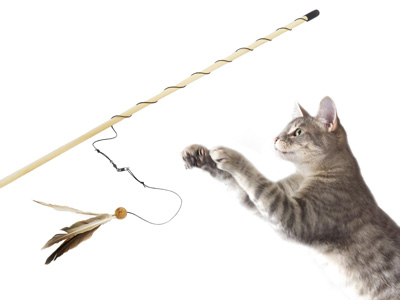
Play and exercise are an important part of pet health. For cats, toys are a great way to stimulate play, combat obesity, discourage unwanted behavior, and provide an outlet for unused energy and predatory instincts. Below are ten highly rated toys that at under $25—most under $10—will help keep your cat happy and healthy and won’t break the bank.
- Da Bird Feather Teaser, online from $7.49. This teaser simulates the motion of a bird at your control. A flick of the wrist and the brightly colored feathers dance and spin enticing your cat to play. Encourages instinctual behaviors and exercise to keep your cat healthy and alert.
- Mylar Crinkle Ball Cat Toys, online from $1.49, an inexpensive, sure-fire hit that your cat will love to bat and bobble around the house.
- Yeowww! Catnip Banana, online price from $4.13. These popular stuffed bananas are made in the USA and filled with organically grown catnip.
- Fat Cat Kitty Hoots Big Mama’s Scratchy Box, online from $8.37. An effective, economical way to satisfy your cat’s desire to scratch and save your furniture. Comes with a supply of "Zoom Around the Room Organic Catnip." The box is 100 percent recyclable. May need to be replaced every 1-2 months, depending on usage.
- PetSafe SlimCat, online from $4.69. PetSafe Slimcat is an interactive feeding ball that works by distributing your cat's food into smaller meals that can be fed at regular intervals. Slimcat can also satiate your cat's craving to hunt which results in a more peaceful pet.
- Petlinks System Dream Curl Curvy Two-Surface Scratcher online from $20.99. Your cat will love the shapely contours of the Dream Curl and its enticing variety of scratching surfaces and angles. Made from Earth-friendly sisal and contains organic catnip. The scratcher core is made from recycled material.
- Tipsy Nip Ball, online from $5. This organic catnip infused non-toxic wooden ball is sure to be a hit with your cat. When not in use, store in the accompanying bottle of catnip to keep the ball catnipalicious.
- Cat Amazing Interactive Puzzle for Cats, from $14.95. This interactive puzzle game has three levels of difficulty to stimulate and challenge cats, and those who complete the puzzle are rewarded with a treat. It is the perfect test of your cat’s skill and ingenuity and is an instant hit wherever people and cats are gathered. Made from 30 percent recycled cardboard and is 100 percent recyclable, and printed with certified metal-free inks.
- The Cat Dancer, available online from $1.79. The Cat Dancer is the original interactive cat toy. Spring steel wire and rolled cardboard create an irresistible lure for cats and great fun for cat lovers. According to their website, The Cat Dancer has been "home-tested by over 8 million cats."
- Teddy for Kitty, $5.95, available online through EcoChoices Natural Living Store, is a teddy bear made from rugged corduroy and a colorful patch and filled with organically grown catnip. Made in the USA.
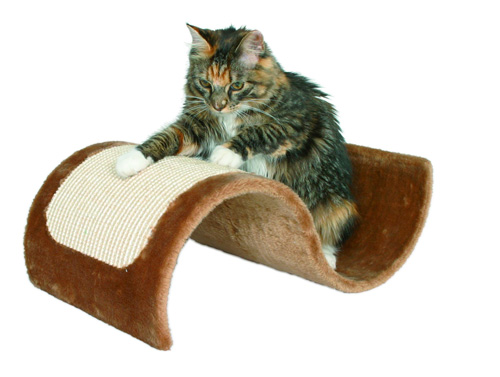
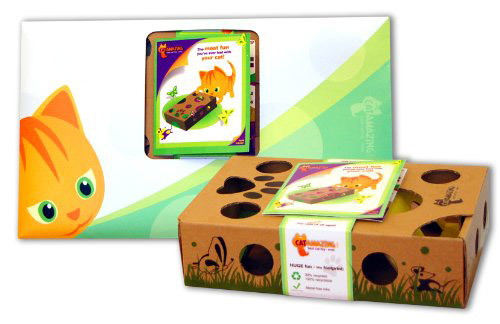
Don’t forget: Homemade cat toys can be just as entertaining as those that are store-bought. Cats love batting around a crumpled ball of paper, hiding in a large paper bag or cardboard box, or attacking an object, such as a feather, bell, or stocking stuffed with catnip, attached to a string or pole. Best of all, you probably have most or all of these items in your home already.

As more and more people turn to natural and healthier eating habits, so do their pets! With over half of American households owning a pet, this creates a huge market that the gourmet pet food industry is dying to tap into. And they are succeeding at record levels.
Gourmet dog food typically contains certain key ingredients, such as potatoes, fiber, and bananas, which work as natural preservatives. But of course, chemical-free, natural products come at a cost. Just as people spend more on their own healthy meals, this is also the case for Fido’s dinner. However, many pet owners are experiencing benefits that justify the more costly natural alternatives, such as improvements in their animal’s health and coat.
Although natural pet food is on the rise, choosing the pricier gourmet or natural products is still far from the norm. All-natural dog food is estimated to represent approximately 10% of the $19 billion pet food industry, and 5% are chef-inspired pet foods. A smaller portion is claimed by human-grade pet food, which is good enough for both the dog dish and the table! Honest Kitchen is the biggest pet food company to claim human-grade status, with a 4 pound box of “Love” (a grain-free, Dehydrated hormone-free beef dish that makes 16 pounds of food) selling at $47.
However, if you’re looking to go natural, human-grade status is not the only way. In fact, many well-established brands, such as Fromm, Merrick, and Purina, as well as newcomers like Petropics, Blue Buffalo, Weruva, Petite Cuisine and Stella & Chewy’s, each present various natural or gourmet options for your dog or cat. So go ahead, spoil little Spot, he deserves it!
With Veteran's Day quickly approaching, it is an opportune time to commemorate not only our soldiers and veterans- but those important canine friends that help our servicemen and servicewomen’s reentry to American life.
Engaging in military battles or conflict can create anxiety in even the hardiest of soldiers. Unfortunately, sometimes that anxiety permeates their emotional state in such a way so as to disrupt their attempts at a "normal" life once they return home.
Oftentimes, returned soldiers can suffer not only from anxiety but also from depression, fear and substance abuse. Anyone who has gone through a life-threatening event can develop Post Traumatic Stress Disorder (PTSD) that can include reliving the experience through memories, nightmares or flashbacks. PTSD can also cause a victim to avoid situations that remind him/her of the event, create negative feelings, and initiate hyperarousal (living with a chronic state of fight or flight). These hard-to-overcome emotions can paralyze veterans, dismantle family life, and prevent an individual’s chance at happiness.
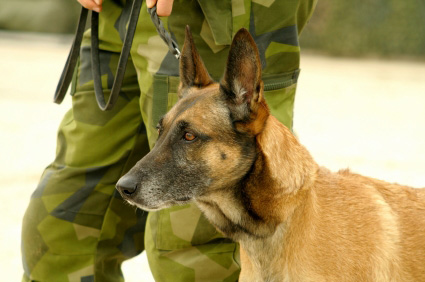
Pawsible Help
A specially trained PTSD dog can give its owner a sense of comfort, security, calm. Like all service dogs, a psychiatric service dog is individually trained to perform tasks that mitigate the owner’s disability. With PTSD, some of these mitigating tasks may involve:
- Providing environmental assessments (entering a room prior to the owner and making sure “the coast is clear”)
- Interrupting an owner’s repetitive or injurious behavior
- Reminding the owner to take medication
- Guiding the handler away from stressful situations.
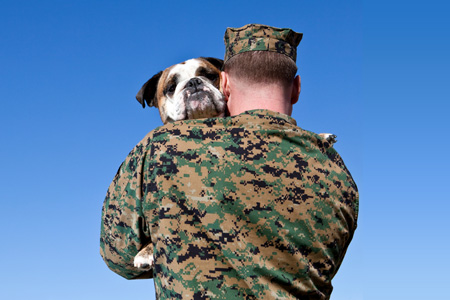
Creature Comforts
Much research has been performed that demonstrates dogs’ ability to serve as good companions, elicit feelings of love and affection, and reduce stress in humans. These and other natural canine virtues make dogs the perfect therapist for a PTSD survivor. These well-trained service dogs draw individuals out of their shells and help them overcome their emotional numbness or fear. Researchers have also concluded that human-dog bonding has biological effects such as adjusting serotonin levels, lowering blood pressure and overcoming depression.
If you or someone you care about has been affected by PTSD and could benefit from special canine companionship, contact either of the following organizations for more information:
- Canines 4 Hope, 1-772-631-4931 or http://www.canines4hope.com/index.htm
- Service Dog Express, http://www.servicedogexpress.com/
4720 W. 109th Ave.
Crown Point, IN 46307
PH (219) 663- 0113
1230 S. Halleck
DeMotte, IN 46310
PH (219) 987-2271
including Munster, Highland, Hammond, Crown Point, DeMotte, Cedar Lake, Dyer, Winfield, Merrillville, Schererville, St. John, Crete, and Beecher
We Accept:



